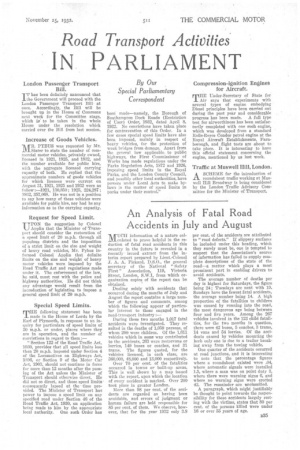An Analysis of Fatal Road Accidents in July and August
Page 53

If you've noticed an error in this article please click here to report it so we can fix it.
MUCH information of a nature calculated to prove helpful in the reduction of fatal road accidents in this country in the future is revealed in a recently issued extract from the interim report prepared by Lieut.-Colonel J. A. A. Pickard, D.S.O., the general secretary of the National " Safety First" Association, 119, Victoria Street, London, S.W.1, from which organization copies of the report can be obtained.
Dealing solely with accidents that occurred during the months of July and August the report contains a large number of figures and comments, among which the following appear of particular interest to those engaged in the road-transport industry :— During these two months 1,017 fatal accidents were investigated. They resulted in the deaths of 1,059 persons, of whom 200 were children. Of the 1,611 vehicles which in some way contributed to the accidents, 263 were motorvans or lorries, 149 buses or coaches, and 31 trams. The figures quoted, for the vehicles licensed, in each class, are 360,000, 48,000 and 13,000 respectively. Over 70 per cent. of the fatalities occurred in towns or built-up areas. This is well shown by a map issued with the report, upon which the location of every accident is marked. Over 200 took place in greater London.
More than 98 per cent. of the accidents are regarded as having been avoidable, and errors of judgment or human failure are held responsible for 85 per cent. of them. We observe, however, that for the year 1932 only 3.8
per cent, of the accidents are attributed to "road defects." If slippery surfaces be included under this heading, which they surely must be, one is tempted to suspect that the Association's source of information has failed to supply complete descriptions of the state of the road—a matter which plays a most prominent part in enabling drivers to avoid accidents.
The average number of deaths per day is highest for Saturdays, the figure being 24; Tuesdays are next with 19. Sundays have the fewest fatal accidents, the average number being 14. A high proportion of the fatalities to children was caused by running into the road, the most dangerous age being between four and five years. Among the 267 vehicles involved in the 123 child fatalities, for the two months in question, there were 42 buses, 5 coaches, 3 trams, 14 vans and 54 lorries. Of the accidents caused by vehicles mounting the kerb only one is due to a trailer breaking away from the towing vehicle.
One quarter of the accidents occurred at road junctions, and it is interesting to note that the percentage figures where a roundabout existed were .04, where automatic signals were installed 1.5, where a man was on point duty 3, where there were warning signs 6, and where no warning signs were erected 43. The remainder are unclassified.
A paragraph, which might justifiably be thought to point towards the responsibility for these accidents largely resting with the victims, states that 80 per cent, of the persons killed were under 16 or over 55 years of age.




































































































